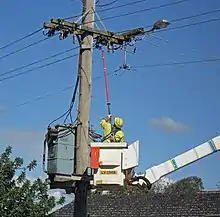Hot stick
In the electric power distribution industry, a hot stick is an insulated pole, usually made of fiberglass, used by electric utility workers when engaged on live-line working on energized high-voltage electric power lines, to protect them from electric shock. Depending on the tool attached to the end of the hot stick, it is possible to test for voltage, tighten nuts and bolts, apply tie wires (twisted lengths of ductile wire which fasten the running cable to its supporting insulators), open and close switches, replace fuses, lay insulating sleeves on wires, and perform various other tasks while not exposing the crew to a large risk of electric shock.[1]

Hot sticks are made in different lengths, from simple 3 foot (1 m) sticks to 30 foot (9 m) telescoping models. Because the fiberglass provides electrical insulation, the hot stick allows utility workers to perform operations on power lines safely without de-energizing them or while the state of the power line is not yet known. This is essential because certain operations (such as opening or closing combination fuse/switches) must occasionally be performed on an energized line. Additionally, after a fault occurs, the exact state of a line may not be certain; in this case, for reasons of crew safety, the utility workers must treat the line as though it were energized until it can be proven that it is not and safety ground cables can be applied to the line (so that the line is guaranteed to remain grounded/earthed while maintenance is performed upon it). If power tools are fitted to the end of the hot stick, they are usually powered hydraulically rather than electrically because, like the fiberglass of the hot stick, the hydraulic fluid is also a good insulator. The hydraulic power is commonly supplied from the bucket truck (cherry picker or aerial work platform) supporting the workers.
The hot stick not only electrically insulates the worker from the energized conductor, it provides physical separation from the device being operated, to reduce the chances of burns which might result from electrical arcing if there is a malfunction of the device being operated.[2]
In the United States, ASTM Standard F 711 specifies the stringent requirements for hot sticks, and U.S. OSHA standards require that they be inspected and electrically tested every two years.[1]
See also
References
- Cadick, John; Capelli-Schellpfeffer, Mary; Neitzel, Dennis (2005). Electrical Safety Handbook. USA: McGraw-Hill Professional. pp. 2.44–2.48. ISBN 0-07-145772-0.
- Hoagland, Hugh; Sannar, Bruce; Givens, Kent; Winn, John; Galo, Luciana (1 May 2003). "Facing Up to the Arc Challenge". Features. Occupational Health & Safety. 1105 Media, Inc. ISSN 0362-4064. Retrieved 25 July 2017.